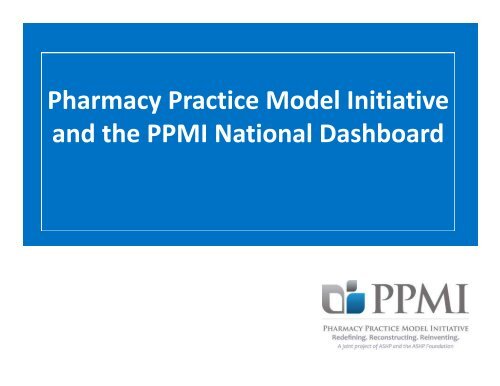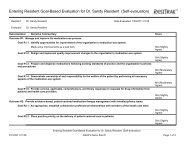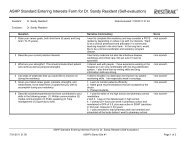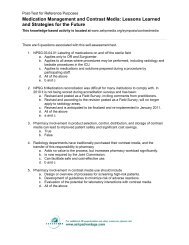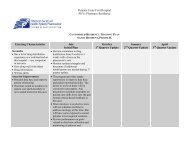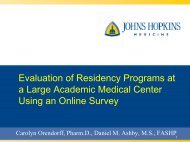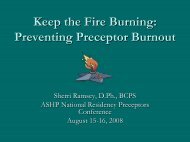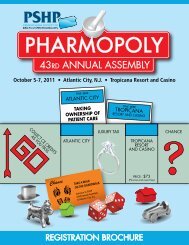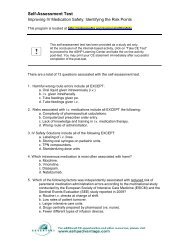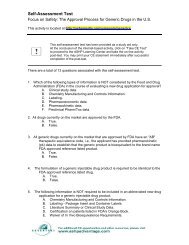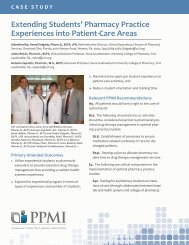Pharmacy Practice Model Initiative and the PPMI National Dashboard
PPMI National Dashboard - Ashpmedia.org
PPMI National Dashboard - Ashpmedia.org
- No tags were found...
Create successful ePaper yourself
Turn your PDF publications into a flip-book with our unique Google optimized e-Paper software.
<strong>Pharmacy</strong> <strong>Practice</strong> <strong>Model</strong> <strong>Initiative</strong><strong>and</strong> <strong>the</strong> <strong>PPMI</strong> <strong>National</strong> <strong>Dashboard</strong>
<strong>Pharmacy</strong> <strong>Practice</strong> <strong>Model</strong> <strong>Initiative</strong>Imperative for a better defined practice model identified by members.Planning commences for summit: assumptions developed, ASHP members,thought leaders, <strong>and</strong> participants queried, briefing papers developed.Consensus summit held resulting in 147 recommendations to better definecharacteristics of <strong>the</strong> optimal practice model for <strong>the</strong> future.SummitProceedingspublished in AJHPBriefing documentwebinar seriesconductedPresentations at MCM,SM, ResidencyConferencesHospital Self-Assessment (HSA)developed, launchedDemonstration <strong>and</strong>resident researchgrants issued<strong>PPMI</strong> Websitewith resources,links launched<strong>National</strong> dashboarddeveloped tomeasure progressComplexity tooldevelopedPolicy issues fromsummit addressed2
<strong>PPMI</strong> <strong>National</strong> <strong>Dashboard</strong>Goal 1 Goal 2 Goal 3 Goal 4 Goal 5Pharmacistroles,practices, <strong>and</strong>activities willimprovemedication use<strong>and</strong> optimizemedicationrelatedoutcomes.<strong>Pharmacy</strong>technicians willprepare <strong>and</strong>distributemedications<strong>and</strong> performo<strong>the</strong>r functionsthat do notrequire apharmacist'sprofessionaljudgment.Pharmacists<strong>and</strong> pharmacytechnicians willhave appropriatetraining <strong>and</strong>credentials for<strong>the</strong> activitesperformed within<strong>the</strong>ir scope ofpractice.<strong>Pharmacy</strong>departmentsutilize availableautomation<strong>and</strong>technology toimprove patientsafety <strong>and</strong>improveefficiency.Pharmacistswill demonstrateleadership inexercising <strong>the</strong>irresponsibility formedication usesystems <strong>and</strong> willbe accountablefor medicationrelatedpatientoutcomes.
GOAL 1: Pharmacist roles, practices, <strong>and</strong> activities willimprove medication use <strong>and</strong> optimize medication relatedoutcomes. (1.1 ‐ 1.4)1.1. Percentage of hospitals/health systems that have pharmacist‐review of all medicationorders before <strong>the</strong> first dose is administered (ei<strong>the</strong>r onsite or via telepharmacy except forprocedure areas <strong>and</strong> emergency situations). [B23b]12 1.2. Percentage of hospitals/health systems sstemsthatthat require that pharmacists document <strong>the</strong>irrecommendations* <strong>and</strong> follow‐up notes in <strong>the</strong> patients' permanent medical records. [B15,B16] *Level <strong>and</strong> type of recommendation as determined by hospital protocol.70.6%54.9%1.3. Percentage of hospitals/health systems where pharmacists have privileges to writemedication orders (modify or initiate <strong>the</strong>rapy) in <strong>the</strong> health care setting. [B13] 88.1%1.4. Percentage of hospitals/health systems where pharmacists have <strong>the</strong> authority to orderserum medication concentrations <strong>and</strong> o<strong>the</strong>r clinically important laboratory tests. [B25h] 83.2%4
GOAL 1: Pharmacist roles, practices, <strong>and</strong> activities willimprove medication use <strong>and</strong> optimize medication relatedoutcomes. (1.5 – 18) 1.8)1.5. 15 Percentage of hospitals/health systems that have pharmacists routinely assigned topatient care units / specialty services to provide drug <strong>the</strong>rapy management at least 8 hoursper day, 5 days a week for a majority of patients? [E4d]1.6. Percentage of hospitals/health systems where pharmacists provide drug <strong>the</strong>rapymanagement to all outpatients who exceed <strong>the</strong> threshold h value on <strong>the</strong> patient medicationcomplexity index. (*to be measured in 2012/13 after index is available) [B9, B11]1.7. Percentage of hospitals/health systems where pharmacists provide drug <strong>the</strong>rapymanagement to all inpatients who exceed <strong>the</strong> threshold value on <strong>the</strong> patient medicationcomplexity index. (*to be measured in 2012/13 after index is available) [B8, B11]1.8. Percentage of hospitals/health systems with pharmacists that routinely provide dischargecounseling <strong>and</strong>/or conduct follow‐up with at‐risk patients or <strong>the</strong>ir pharmacies after discharge.[B20, B22, B23m]34.2%N/S*N/S*20.3%Composite Score: 58.6%5
GOAL 3: Pharmacists <strong>and</strong> pharmacy technicians will haveappropriate training <strong>and</strong> credentials for <strong>the</strong> activitesperformed within <strong>the</strong>ir scope of practice.3.1. 31 Percentage of hospital pharmacists who are board certified by <strong>the</strong> Board of <strong>Pharmacy</strong>Specialties. [B10] 8.8%3.2. Percentage of pharmacists that have completed ASHP‐accredited residency training.[B25p] 17.8%3.3. Percentage of hospitals/health systems who have a credentialing <strong>and</strong> privilegingprocess* beyond licensure that defines <strong>and</strong> authorizes pharmacists' scope of practice.[B23r]15.5%3.4. Percentage of pharmacy technicians working in hospitals/health systems who havecompleted ASHP‐accredited training. [B6d, D5] 11.1%3.5. Percentage of pharmacy technicians working in hospitals/health systems who arePTCB certified. [B6d, D6] 65.8%Composite Score: 23.8%7
GOAL 4: <strong>Pharmacy</strong> departments utilize availableautomation <strong>and</strong> technology to improve patient safety <strong>and</strong>improve efficiency.i4.1. Percentage of hospitals/health systems using a computerized prescriber order entry(CPOE) system with clinical decision support for inpatient medication orders (e.g., rules thatintegrate order information, patient information, <strong>and</strong> clinical practice guidelines intocomputer system logic that provide feedback to prescribers). [C2b, C2d]4.2. Percentage of hospitals/health systems that routinely use machine readable coding (e.g.,bar coding technology with or without a robot) in <strong>the</strong> inpatient pharmacy to verify dosesduring dispensing. [C2j]34.2%33.9%4.3. Percentage of hospitals/health systems that use automated dispensing technologies (e.g.,automated dispensing cabinets, robotics). [C2k] 89.1%4.4. Percentage of hospitals/health systems who have smart infusion pumps that areintegrated into a closed loop medication‐use process (i.e., where CPOE/pharmacy informationsystem is integrated with pumps, <strong>and</strong> administration is documented on eMAR). [C2m]4.5. Percentage of hospitals/health systems that use machine‐readable coding (e.g., Bar‐CodeMedication Administration [BCMA] system) to verify <strong>the</strong> identity of <strong>the</strong> patient <strong>and</strong> <strong>the</strong>accuracy of medication administration at <strong>the</strong> point‐of‐care. [C2l]12.2%50.2%Composite Score: 43.9%8
GOAL 5: Pharmacists will demonstrate leadership in exercising<strong>the</strong>ir responsibility for medication use systems <strong>and</strong> will beaccountable for medication‐related patient outcomes.5.1. Percentage of hospitals/health systems whose pharmacists with drug <strong>the</strong>rapymanagement responsibilities are held accountable through formal evaluation for clinical 30.0%0%outcomes of patients under <strong>the</strong>ir care. [B1, B7]5.2. Percentage of hospitals/health systems whose pharmacy executive is recognized <strong>and</strong>positioned in <strong>the</strong> organization to influence decisions on strategic issues affecting68.4%medication use (e.g., pharmacy department reports to <strong>the</strong> CEO or COO). [B6a]5.3. Percentage of hospitals/health systems that regularly* conduct strategic planning todetermine <strong>the</strong>ir optimal scope <strong>and</strong> level of pharmacy services, use of automation <strong>and</strong>technology, assignment of technicians, <strong>and</strong> readiness of staff to serve <strong>the</strong>ir patient59.2%population. [E1]*Strategic planning has been conducted in <strong>the</strong> past 24 months.5.4. Percentage of hospitals/health systems that have used <strong>the</strong> <strong>PPMI</strong> Hospital Self‐Assessment Tool at least annually. (*to be surveyed in 2012) [E2]5.5. Percentage of hospitals/health systems that conduct proactive <strong>and</strong> ongoingassessments <strong>and</strong> mitigate risk of medication‐use systems (e.g., ISMP Medication Safety SelfAssessment). [B17, B24e]5.6. Percentage of hospitals/health systems that routinely provide training to pharmacystudents <strong>and</strong>/or residents. [E4o, B26]N/S*53.6%62.3%Composite Score: 54.7%9
<strong>PPMI</strong> <strong>National</strong> <strong>Dashboard</strong>Goal 1Goal 2Goal 3Goal 4 Goal 5Pharmacistroles, practices,<strong>and</strong> activities willimprove medicationuse <strong>and</strong> optimizemedication relatedoutcomes.<strong>Pharmacy</strong> ytechnicians willprepare <strong>and</strong>distributemedications <strong>and</strong>perform o<strong>the</strong>rfunctions that t donot require apharmacist'sprofessionaljudgment. Pharmacists<strong>and</strong> pharmacytechnicians willhave appropriatetraining <strong>and</strong>credentials for<strong>the</strong> activitesperformed within<strong>the</strong>ir scope ofpractice.<strong>Pharmacy</strong>departments utilizeavailableautomation <strong>and</strong>technology toimprove patientsafety <strong>and</strong> improveefficiency.Pharmacists willdemonstrateleadership inexercising <strong>the</strong>irresponsibility formedication usesystems stems <strong>and</strong> will beaccountable formedication-relatedpatient outcomes.60 60 606040 80808040804040 40608020 10020 10020 10020 10020 1000000058.6%19.5% XX%23.8%43.9%54.7%


